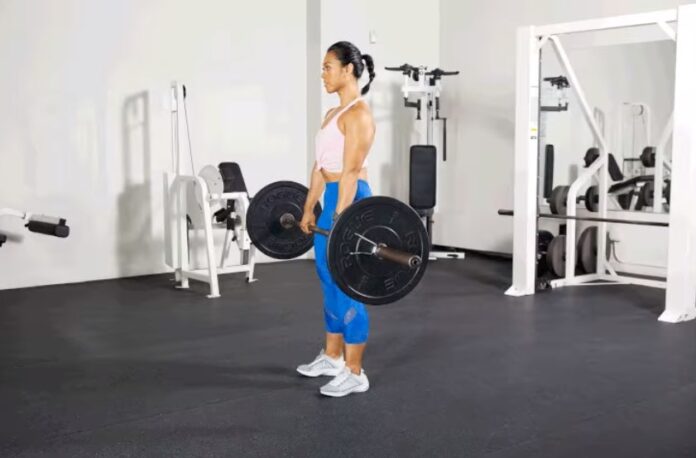The deadlift is a great way to build strong legs and butt. In a deadlift, you lift weight from the ground to thigh level using primarily your leg and hip muscles, but with the assistance of most of the large muscle groups of your body. The deadlift is usually performed with a bar and plates or a fixed barbell, but you can do it with dumbbells Deadlifts: Proper Form, Variations, and Common Mistakes. You shouldn’t disregard powerlifters’ specialty when doing general fitness training. Include deadlifts in your strength training regimen to increase muscular mass and functional fitness.Deadlifts: Proper Form, Variations, and Common Mistakes
How to Perform a Deadlift
Select a lightweight barbell or two dumbbells.
- Just outside of your knees, put the bar using an overhand or mixed grip.
- Position your feet shoulder-width apart (or not much more) with toes under the bar. Your feet point straight ahead, or they can angle out slightly. Heels should stay flat on the surface. As you lift and lower the bar, it will travel close to the shins and may even graze them. Maintain a neutral spine position.
- Engage your abdominal muscles.Deadlifts: Proper Form, Variations, and Common Mistakes
- Slowly bring the weight down as far as you can while maintaining proper form, softening your knees, and keeping your back flat.Deadlifts: Proper Form, Variations, and Common Mistakes
- Lift the bar by pushing upward with the legs from the knees. Breathe out on exertion. Be careful not to raise the hips first so the trunk moves forward and the back becomes rounded. Don’t try to haul the bar up with your arms. As the legs push up, the arms remain extended and tensely hold the bar. Imagine the hips, the center of balance, moving up in tandem with the shoulders and legs.
- When you reach your full height, the bar should almost touch your shins before resting around your thighs. Without leaning over, as much as you can, pull your shoulders back.
- Making sure to keep your back straight, lower the bar in a reverse motion toward the floor.
- Repeat for your desired number of repetitions.
Benefits of Deadlifts
The deadlift uses the hamstrings (back of thigh), quadriceps (front of thigh), gluteals (butt), and lower back muscles (erector spinae). The stabilizer muscles of the core, abs, shoulders, and upper back also come into play.Deadlifts: Proper Form, Variations, and Common Mistakes
Builds Muscle Mass
Bodybuilders and those seeking to stop or reverse age-related muscle loss find that deadlifts are an excellent way to gain muscle growth.You can use deadlifts to build overall strength, core strength, and stability.Deadlifts: Proper Form, Variations, and Common Mistakes
Boosts Metabolism
Your metabolism determines the amount of calories you burn while at rest.Lean muscle enhances your metabolism. You can assist speed up your metabolism by gaining more lean muscle in your body. Since deadlifts work with some of the largest muscle groups in the body, they are a good choice for building a greater percentage of lean muscle in your body.Deadlifts: Proper Form, Variations, and Common Mistakes
Builds Functional Fitness
The deadlift is an excellent approach to mimic the lifting you do on a daily basis, making it a functional workout. If you can deadlift with good technique, you can lift and carry objects more safely in your daily life.
Other Variations of Deadlifts
The deadlift can be altered to meet your objectives and degree of fitness. There are other advanced variations that can be imagined, with varying leg and grip placements.
As with all exercises, if you are new to deadlifting, lift only light weights or even a bar without any additional weight. Have a personal trainer coach you and give feedback on your form. Increase weight when you are performing it correctly.Deadlifts: Proper Form, Variations, and Common Mistakes
Dumbbell Deadlifts
If you don’t have access to a barbell or the bar’s weight is too challenging, try a kettlebell or vertical dumbbell deadlift with a lighter weight. Grasp the object with both hands and hinge at the hips to lift it, as with a barbell. Alternatively, workout sandbags can be used for a variety of full-body exercises, including deadlifts.Deadlifts: Proper Form, Variations, and Common Mistakes
Romanian Deadlifts
The primary distinction between Romanian deadlifts and standard deadlifts is that the former begin the lift from a standing posture, while the latter do so from a squat. This variation works the posterior chain muscles, which include the muscles that run along the back side of your body, such as the glutes, hamstrings, and calves.1 You can also do the Romanian deadlift with offset feet, which may more closely mimic real-life situations in picking up and moving heavy objects.Deadlifts: Proper Form, Variations, and Common Mistakes
Stiff-Leg Deadlift
With this variation of the deadlift, you stay upright the entire time, maintaining a straight spine and nearly locked knees.Maintain a neutral spine and keep the bar close to your body as you bend forward and return to standing. The stiff leg deadlift activates the hamstrings and gluteus maximus more than standard or Romanian deadlifts.Deadlifts: Proper Form, Variations, and Common Mistakes
Suitcase Deadlift
This variation calls for lifting weight with just one hand, one side of the body at a time. Visualize the motion involved in carrying a bag.
It is excellent for strengthening your core, as you engage those muscles to prevent your body from leaning over to the side with the weight. Keeping your legs straight is not necessary for this exercise; instead, you must bend as if you were performing a regular deadlift.
Change Your Deadlift Grip
These are the possible grip types while performing deadlifts:
The palms of both hands are facing the body while using the normal overhand grip. The overhand grip is demonstrated if the backs of both hands are visible. This grip works well with smaller weights.
- The mixed grip has one hand grasping the bar with the palm under the bar (supinated) and the other with the palm over the bar (pronated). The mixed overhand-underhand grip is for heavier weights. This grip provides some reassurance that heavier weights will not slip from the hands.
On the bar, the grip can be either wider or narrower. Arms straight down with a grip perpendicular to the shoulder point are common beginning positions. A slightly wider grip may suit some people, and a wide-grip deadlift is a valid variation. The standard grip utilizes the quadriceps (rather than the hip and back with the wide grip) and is more suitable for heavier lifts.Deadlifts: Proper Form, Variations, and Common Mistakes
Deadlift Common Mistakes
Deadlifts have so many benefits, but doing them correctly is paramount. Injury from deadlifts could leave you unable to exercise while you recover, so it’s not worth taking risks. Avoid these errors so you can get the most out of this exercise with less risk of strain or injury.Deadlifts: Proper Form, Variations, and Common Mistakes
Rounding Your Back or Shoulders
Avoid hunching your shoulders or curving your spine by maintaining a straight back. It is proper to hang from the hips. Butt out and keep those hips down. To support your straight back, contract your core.
Lifting With Your Arms or Back
For beginners, the key to the lifting process is to lift with the legs and hips, not the arms, shoulders, or back—although their stabilizing role is important. Maintain a straight arm position during the deadlift. Bicep strain can occur when you bend your arms.
Using Too Much Weight
When starting, practice with light weight until your form is satisfactory. A personal trainer or gym attendee can check you for the correct form. Practice in a mirror if necessary. You can add weight as your fitness increases, but it’s better to do so modestly so you don’t strain your muscles. As with all weightlifting exercises, proper footwear, like these best CrossFit shoes, is essential.
Partial Lifts
With a light weight, you can do repetitions in which you lower the bar to your shin or even floor and then straighten again without releasing your grip on the bar. This isn’t really a repetition of a deadlift. It is preferable to practice a full lift, descend to the ground, and then stand back up.
Bar Too Far From Body
Sometimes when people perform deadlifts, they position the weight too far away from the body. The bar should travel close to the body for maximum lift efficiency and safety. It’s OK to skim the front of your legs as you lift and lower.Deadlifts: Proper Form, Variations, and Common Mistakes
Safety and Precautions
The deadlift is an advanced weightlifting exercise. Talk to a healthcare provider to see if it is appropriate for you if you have any injuries or conditions affecting your legs, knees, ankles, hips, back, shoulders, or wrists. Be sure you receive appropriate coaching for the correct technique. Use light weights to start, and stop if you feel any pain. In pregnancy, it is best to use lighter weights, and you may wish to use the wider sumo stance. Women should consider wearing a high-neck sports bra for extra support.Deadlifts: Proper Form, Variations, and Common Mistakes

